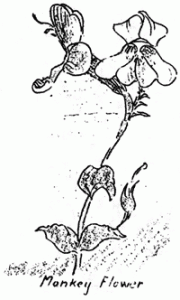Monkey Flowers
By Lincoln Constance, Ranger Naturalist
Perhaps no group of plants contributes more varied and alternative blossoms to the floral population of Crater Lake National Park than the Monkey-flowers. While most of them prefer a swampy habitat, individuals may be found almost throughout the area. Even on the top of some of the higher points of the Rim we meet them, and they adorn the Lake Trail from top to lakeshore.
Monkey-flowers are members of the Figwort family, and bear a close resemblance to many of their relatives, such as, the Snap dragons, Fox gloves, Beard tongues, and others. At Crater lake we have five or six varieties, ranging from deep red to pink and thence through several shades of yellow. The leaves are borne in opposite pairs and the stems are relatively weak, and distinctly herbaceous.
The so-called Common Monkey-flower (Mimulus glutinosus) is usually found growing along streams, or in other very moist places. It seems to occur almost everywhere throughout the West Coast, in several Life Zones. Its height and general appearance depend largely upon the conditions in which it is forced to live, so we may find it growing three or four feet high, with immense yellow flowers. Our representatives, however, are largely a depaupourized or stunted form (var. depaupourperatus), and the golden flowers are small in size.
Another yellow Monkey-flower is the “Muskey-scented Monkey flower” (Mimulus moschatus), which prefers a well-shaded site, growing best under alders and other trees. It has a woolly stem and leaves, and the plant frequently reclines upon the ground instead of growing erect. As its name would imply, it does give off a faint, musky order, but it is too weak to be called offensive.
In the Castle Crest Flower Garden we frequently see a carpet of brilliant light yellow flowers, borne on short stems, over a rosette of small leaves. This is the “Primrose Monkey-flower” (Mimulus primuloides), and perhaps one of the most attractive, if not as showy as some of its cousins. It must have lots of moisture, and have it close at hand in order to thrive. The yellow corolla, or blossom, is daintily marked with blotches of brown or purple, following a regular pattern. Growing beside this plant is a very, very tiny flower of much the same appearance. The individual flowers are seldom more than a quarter of an inch across, and the purple markings are definitely arranged “beauty spots”. Whether this is merely a dwarf form of the “Primrose Monkey flower”, or a distinct species, we have not definitely decided.
The “Pink” or “Lewis Monkey flower” (Mimulus lewisii) is by far the most gaudy member of the group to be found in our environs. The blossoms are pale pink, rose, or almost purple, charmingly marked with bright yellow. Along the streams, in the flower garden, and even along the Lake Trail, this brilliant bloom is sure to draw the interest of the most casual observer. The flowers are borne at the end of the stem, and usually only one or two bloom at a time. They are so large and showy, that many have mistaken them for Petunias, and not without some reason.
When you parked your car on the top of Cloud Cap, you may have noticed that the pumice by the roadside was ensanguined in places by masses of tiny red flowers. This is the favorite habitat of one of the “Dwarf Monkey-flowers” (Mimulus nanus, in this case). It seems very odd to see a member of this water-esteeming genus choosing such an exposed and arid home, but there is no denying this case. It is dwarfed by lack of water, though, and is usually only an inch or two high, the whole plant frequently having a reddish or purplish cast.
The petals of the Monkey-flowers are united into a corolla, which is frequently cut partly in half, or “two-lipped”. This arrangement gives the blossoms an odd resemblance to little faces, as they peer up from their green bed. It required no great expenditure or imagination for a fanciful flower lover to liken them to the countenances of little simians, and thence, no doubt they derived their common name.


